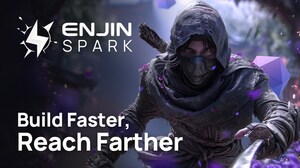Enjin Blockchain "Triple Migration" Successful; 51% Complete in First 60 Days
Oscar Franklin Tan, Chief Financial Officer and Chief Legal Officer, Atlas Development Services
SINGAPORE, Nov. 15, 2023 /PRNewswire/ -- 51% of native Enjin Coin (ENJ) on Enjin Blockchain allocated for swaps of ERC-20 tokens have been successfully claimed to date, following the launch of Enjin Blockchain's token migration over 60 days ago last September 13. This percentage completion is rapid given how widely distributed ERC-20 ENJ was, with over 80% distributed immediately at its 2017 launch and with over 170,000 unique addresses (excluding accounts in centralized platforms) pre-migration. This successful initial migration secures Enjin Blockchain and grounds initial governance and staking in this proof of stake blockchain, ahead of the 250 million ENJ early governance rewards to be released in 10 equal intervals beginning January 15, 2024.
Enjin Blockchain is a blockchain custom built for non-fungible token (NFT) transactions at the protocol level, and is supported by an app layer for no-code NFT integration into indie games and other platforms. ENJ was the first NFT/metaverse token, launched in 2017 and became the foundation for the world's first NFT gaming ecosystem and one of the world's largest token ecosystems.
45% of migration claims were for less than 1,000 native ENJ, and 77% were for less than 10,000 native ENJ (excluding accounts in centralized platforms). This figure is much higher if including automatic native EFI conversions. Remaining ERC-20 token holders are encouraged to migrate their tokens to further secure Enjin Blockchain and be part of initial governance and staking.
Progress of Token and NFT Migration
ENJ was launched in 2017 as an ERC-20 token with a fixed supply of 1 billion. 34% of ERC-20 ENJ have been migrated to Enjin Blockchain to date.
Efinity was the native token of the Efinity parachain, the first non-fungible token (NFT) parachain and the sixth parachain on Polkadot. Efinity was launched as an ERC-20 token in 2021 ahead of the Polkadot crowdloans, with a fixed supply of 2 billion, and later became available as a native token. 85% of EFI have been migrated to Enjin Blockchain to date.
The Efinity parachain was migrated to Enjin Blockchain, becoming what is now Enjin Matrixchain. Enjin Blockchain is initially composed of Enjin Relaychain and Enjin Matrixchain. All native EFI was automatically converted to native ENJ; thus, all remaining EFI are ERC-20 tokens not yet migrated. The Efinity community approved the Efinity migration in governance referendum GP-2023-06-14 on June 29, 2023.
Enjin Blockchain contains a claims pallet that allows migration of ERC-20 ENJ to Enjin Blockchain native ENJ at a 1:1 ratio, and migration of ERC-20 EFI at a 4 EFI : 1 ENJ ratio. External interfaces (currently Enjin Wallet) may connect to the claims pallet to facilitate token migrations. There is currently no proposed closing date for the claims pallet, although users need to migrate tokens to Enjin Blockchain to use its functionality and participate in governance and staking.
Enjin Blockchain had an initial supply of 1.75 billion ENJ, with 1 billion allocated for migrating ERC-20 ENJ, 500 million for migrating EFI, and 250 million for early governance rewards.
A pending Ethereum NFT migration will follow the Enjin Blockchain token migration (see below), with all Efinity NFTs already migrated to Enjin Blockchain.
Triple Chain Token and NFT Migration Structure
The Enjin Blockchain token and NFT migration is an unprecedented organizational and technological feat, being:
1) one of few triple-chain migrations in history;
2) the only multi-chain migration of both fungible and non-fungible tokens; and
3) the largest Ethereum to Substrate token migration since Polkadot.
A cross-chain migration, by definition, cannot be fully on-chain because it involves at least two different chains. A mechanism, such as the Enjin Blockchain claims pallet in this case, must securely destroy existing Ethereum tokens, then link the user's Ethereum address to an address on the new chain and issue new tokens on the new chain.
The Enjin Blockchain claims pallet sends existing ERC-20 ENJ or EFI to the Ethereum burn address (0x000000000000000000000000000000000000dEaD), a special and well-known inaccessible Ethereum address specifically for destroying tokens. The process then requires the Ethereum token holder to sign and link the Ethereum address to an Enjin Blockchain address, allowing the holder to claim native ENJ in the new Enjin Blockchain address. Again, external interfaces may connect to the claims pallet (currently Enjin Wallet) to facilitate this process.
However, the Enjin Blockchain migration is a rare triple-chain token migration because of Efinity. In the case of Efinity, the mechanism was the migration of the entire parachain to Enjin Blockchain and conversion of its native token from EFI to ENJ.
Few ecosystems have the development, organizational and legal resources required to execute such an unprecedented triple-chain migration, and a triple migration with both fungible and non-fungible tokens. This underscores the importance of the migration's rapid progress within the first 60 days.
Further, the token migration will be followed by a planned NFT migration. A snapshot of Enjin NFTs on Ethereum will be taken at an announced date and these NFTs will be mirrored on Enjin Blockchain. A cross-chain mechanism will allow the NFT holders to sign using the Ethereum address and claim the corresponding Enjin Blockchain NFT. Existing Ethereum Enjin NFTs will not be burned to avoid Ethereum gas fees, and the Enjin Blockchain NFTs are intended to be the definitive NFTs post-snapshot.
This architectural choice demonstrates the triple migration's challenges. A longtime ENJ user with both ERC-20 ENJ and Ethereum NFTs would likely have a wallet containing a single ENJ balance but multiple NFTs. The user would thus need to pay a single Ethereum gas fee to transfer ENJ but multiple gas fees to transfer each NFT. Gas fees thus force a practical design choice to require burning ERC-20 ENJ but mirroring Ethereum NFTs in Enjin Blockchain without burning the existing Ethereum NFTs. Of course, minimizing gas fees and allowing developers to intelligently subsidize these with targeted permissions via fuel tanks are fundamental to the Enjin Blockchain vision.
Initial Governance and Staking
It remains imperative to bring a majority of ENJ holders into Enjin Blockchain, to secure the chain and drive governance and staking. Enjin Blockchain's initial design provides for an early governance rewards pool of 250 million ENJ.
ENJ gave rise to the world's first NFT gaming ecosystem and a decentralized, self-selected community of NFT and NFT gaming enthusiasts, with over 170,000 unique addresses (excluding accounts in centralized platforms) pre-migration. This community in turn drew from the users of Enjin, a gaming community software company founded by Maxim Blagov and Witek Radomski in 2009 whose Enjin CMS (content management system) had 21 million users at its peak.
Enjin Blockchain uses Substrate proof of stake architecture and envisioned attracting the existing ENJ community to provide security and drive governance and staking. Enjin Blockchain's initial design provides for an early governance rewards pool of 250 million ENJ, to be released in 10 equal intervals beginning January 15, 2024. Each interval will be 30 eras in Enjin Blockchain or approximately 30 calendar days, and 25 million ENJ will be released at each release date. These rewards will be distributed to those participating in Enjin Blockchain governance, by staking ENJ in nomination pools that select network validators.
Enjin Blockchain features token inflation to support network governance at a rate of 4.8927482% per annum, with new tokens released per era or approximately daily. This ENJ is distributed among active network validators. Each such validator retains a chosen percentage, then in turn distributes the remaining ENJ to the nomination pools that nominated that validator. Each such nomination pool in turn retains a chosen percentage of ENJ and distributes the remaining ENJ to individual holders who participated in the pool by staking ENJ and supporting the pool's choice of validator. This ENJ constitutes governance rewards to such staked holders. Such participation in governance and staking may be supported by external interfaces (currently Enjin Wallet and Enjin Blockchain Console).
Separate from governance and staking, Enjin Blockchain's NFT transfer functions and its supporting app layer are live. These include:
- Fuel tanks, an on-chain feature that allows developers to subsidize users' transaction fees. Beyond simply free transactions, fuel tanks allow targeted subsidies such as free transactions for entry-level or beginner NFT collections, or specific featured collections.
- Enjin Platform, APIs and SDKs that grant even solo indie developers no-code NFT integration into games and other platforms within 48 hours, without need to spend for expensive blockchain development.
- Enjin Wallet Daemon, an automated system for signing blockchain transactions that frees developers from having to manually sign transactions such as NFT issuances within games. This comes with a visual user interface that makes it easy to use for even novice developers.
- Enjin Wallet, a secure and easy-to-use mobile blockchain wallet that seamlessly plugs into games and other platforms with Enjin Platform.
- NFT.io, a proprietary NFT marketplace supporting Enjin Blockchain
Participation in Enjin Blockchain Migration and Governance
Again, remaining ERC-20 token holders are encouraged to migrate their tokens to further secure Enjin Blockchain and be part of initial governance and staking. Enjin Blockchain's initial design provides for an early governance rewards pool of 250 million ENJ, to incentivize holders to participate early in this security, governance and staking.
How to migrate ERC20 ENJ / EFI tokens to Native ENJ
Migrating on Enjin Wallet (video)
How to participate in Enjin Blockchain governance and staking
Participating in Enjin Blockchain Governance and Staking on Enjin Wallet (video)
SOURCE Enjin

WANT YOUR COMPANY'S NEWS FEATURED ON PRNEWSWIRE.COM?
Newsrooms &
Influencers
Digital Media
Outlets
Journalists
Opted In



Share this article